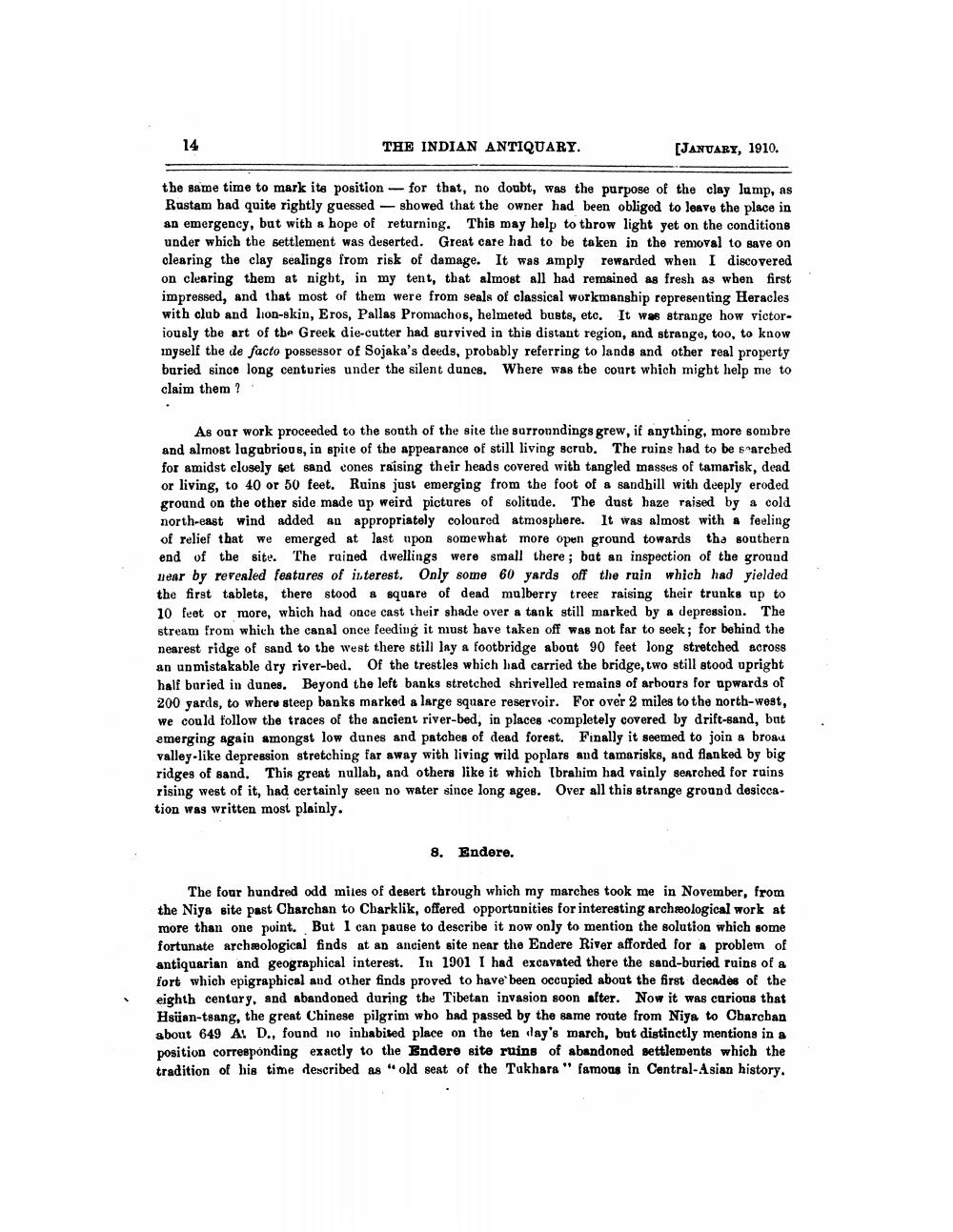________________
14
THE INDIAN ANTIQUARY.
[JANUARY, 1910.
the same time to mark its position - for that, no doubt, was the purpose of the clay lamp, as Rastam bad quite rightly guessed - showed that the owner had been obliged to leave the place in an emergency, but with a hope of returning. This may help to throw light yet on the conditions under which the settlement was deserted. Great care had to be taken in the removal to save on clearing the clay sealings from risk of damage. It was amply rewarded when I discovered on clearing them at night, in my tent, that almost all had remained as fresh as when first impressed, and that most of them were from seals of classical workmanship representing Heracles with club and lion-skin, Eros, Pallas Promachos, helmeted busts, etc. It was strange how victoriously the art of the Greek die-cutter had survived in this distant region, and strange, too, to know myself the de facto possessor of Sojaka's deeds, probably referring to lands and other real property buried since long centuries under the silent dunes. Where was the court which might help me to claim them?
As our work proceeded to the south of the site the surroundings grew, if anything, more sombre and almost lagabrious, in spite of the appearance of still living scrab. The ruins had to be s arcbed for amidst closely set sand cones raising their heads covered with tangled masses of tamarisk, dead or living, to 40 or 50 feet. Ruins just emerging from the foot of a sandhill with deeply eroded ground on the other side made up weird pictures of solitude. The dust haze raised by a cold north-east wind added an appropriately coloured atmosphere. It was almost with a feeling of relief that we emerged at last upon somewhat more open ground towards the southern end of the site. The ruined dwellings were small there; bat an inspection of the ground near by revealed features of interest. Only some 60 yards off the ruin which had yielded the first tablets, there stood a square of dead mulberry trees raising their trunks up to 10 feet or more, which had once cast their shade over a tank still marked by a depression. The stream from which the canal once feeding it must have taken off was not far to seek; for behind the nearest ridge of sand to the west there still lay a footbridge about 90 feet long stretched across an unmistakable dry river-bed. Of the trestles which had carried the bridge, two still stood upright half baried in dunes. Beyond the left banks stretched shrivelled remains of arbours for upwards of 200 yards, to where steep banks marked a large square reservoir. For over 2 miles to the north-west, we could follow the traces of the ancient river-bed, in places completely covered by drift-sand, but emerging again amongst low dunes and patches of dead forest. Finally it seemed to join a broau valley-like depression stretching far away with living wild poplars and tamarisks, and flanked by big ridges of sand. This great nullah, and others like it which Ibrahim had vainly searched for ruins rising west of it, had certainly seen no water since long ages. Over all this strange ground desiccation was written most plainly.
8. Endere.
The four hundred odd miles of desert through which my marches took me in November, from the Niya site past Charchan to Charklik, offered opportunities for interesting archeological work at more than one point. But I can pause to describe it now only to mention the solution which some fortunate archæological finds at an ancient site near the Endere River afforded for a problem of antiquarian and geographical interest. In 1901 I had excavated there the sand-buried ruins of a fort which epigraphical and other finds proved to have been occupied about the first decades of the eighth century. and abandoned during the Tibetan invasion soon after. Now it was curious that Hsüan-tsang, the great Chinese pilgrim who had passed by the same route from Niya to Charcban about 649 A: D., found no inhabited place on the ten day's march, but distinctly mentions in a position corresponding exactly to the Endere site ruins of abandoned settlements which the tradition of his time described as "old seat of the Tukhara" famous in Central-Asian history,




